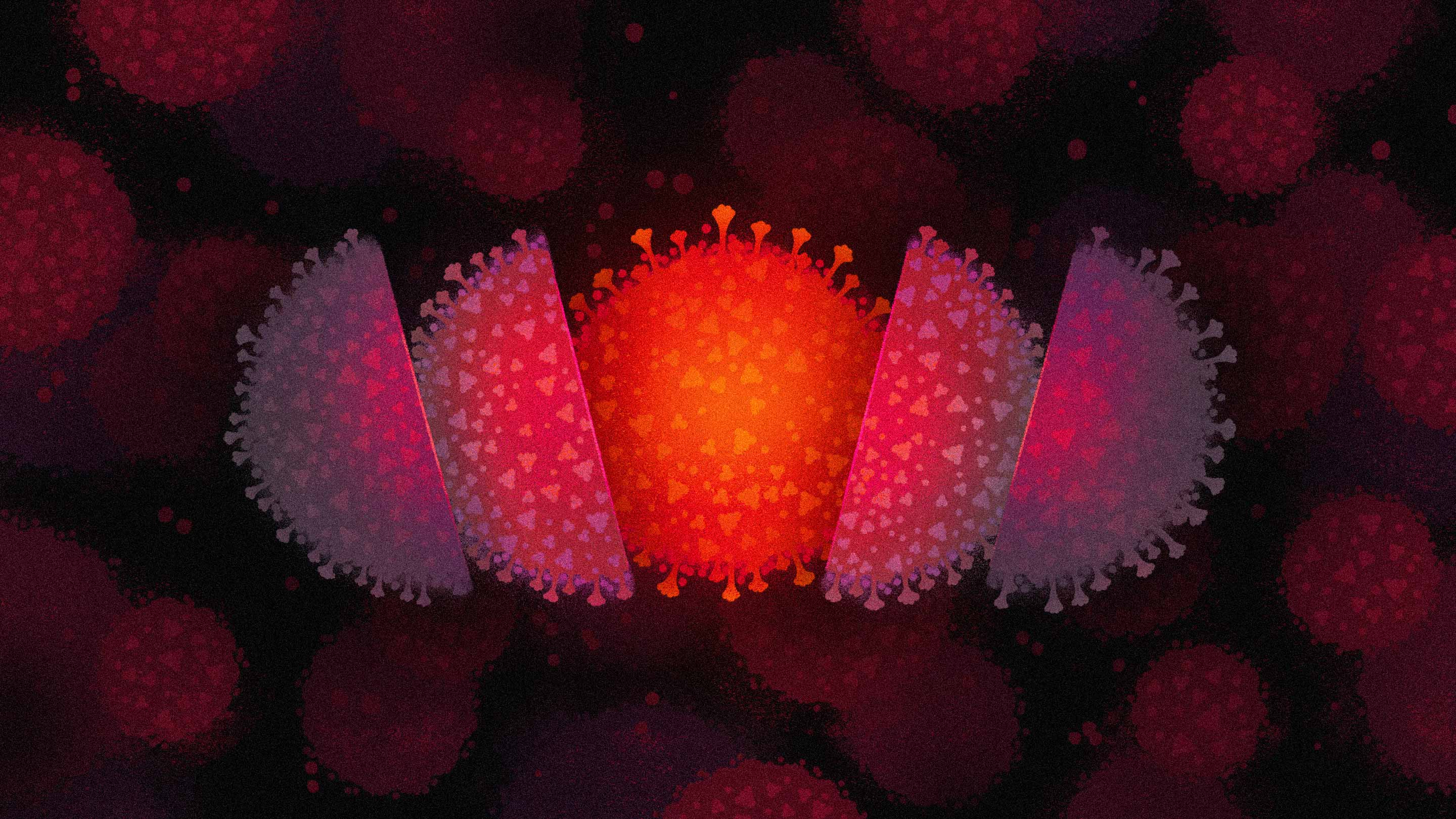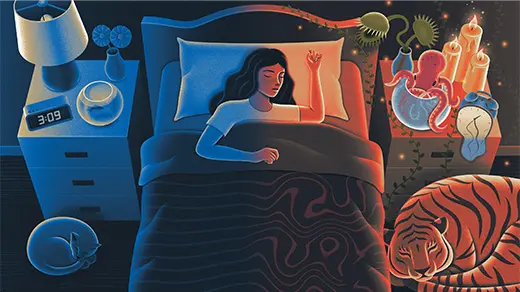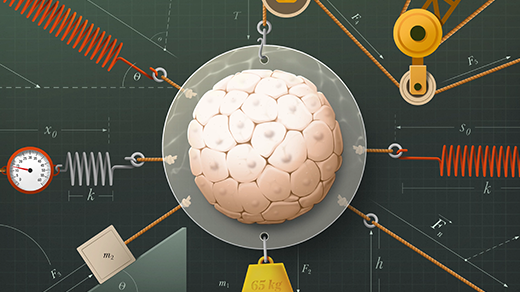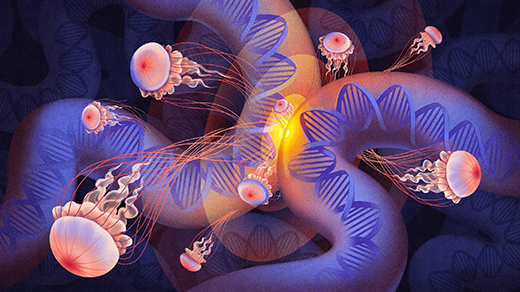How to Understand COVID-19 Variants and Their Effects on Vaccines

Maggie Chiang for Quanta Magazine
Introduction
Viruses evolve. It’s what they do. That’s especially true for a pandemic virus like SARS-CoV-2, the one behind COVID-19. When a population lacks immunity and transmission is extensive, we expect viral mutations to appear frequently simply due to the number of viruses replicating in a short period of time. And the growing presence of immune individuals means that the viruses that can still transmit in these partially immune populations will be favored over the original version. Sure enough, that’s what we’ve been seeing, as news reports warn of the appearance of novel variants (viruses with several mutations, making them distinct from their ancestors) and strains (variants that are confirmed to behave differently from the original).
To be clear, mutations are random errors that occur when a virus reproduces. In the case of SARS-CoV-2, which has an RNA genome based on adenine, cytosine, guanine and uracil, sometimes mistakes happen. Maybe an adenine gets swapped with a uracil (a substitution mutation that could also occur with any of the base pairs), or perhaps one or more bases get inserted or deleted. If a mutation actually changes the protein encoded by that part of the RNA sequence, it’s referred to as a non-synonymous mutation. Mutations that do not result in a protein change are referred to as synonymous, or silent, mutations.
Luckily, the mutation rate of coronaviruses generally is relatively slow, due to a proofreading ability in the virus that allows for some correction of replication mistakes. Typically SARS-CoV-2 will accumulate only two mutations per month among its genome’s 30,000 base pairs; that’s half the rate of an influenza virus, and a quarter of the rate of HIV. But with more than 100 million people infected to date, non-synonymous mutations are inevitable. The bigger issue is determining which mutations actually provide the virus enough of an advantage to increase its spread through the population.
Fortunately, at this point we have the knowledge to answer some of the most pressing questions.
When did different strains of the SARS-CoV-2 virus start appearing?
The first mutation we learned about was the D614G mutation, first reported in March 2020. When a mutation causes a change in the protein sequence, its name refers to the ancestral amino acid, its location and then the new amino acid. This mutation changed the amino acid aspartate (abbreviated as D) at the 614th position in the virus spike protein into glycine (G). Because the spike protein enables the virus to bind to host cells, the change is significant; mutations here could help it to bind more efficiently to the host receptor (called ACE2).
However, it’s not clear yet if that’s the case with D614G. The authors of a paper describing the mutation suggested that the rapid spread of variants carrying this mutation, combined with in vitro analyses of viral behavior and clinical data involving people infected with it, meant that D614G provided a selective advantage to these variants, and the mutation was therefore spreading. Others were not convinced, suggesting an alternative rationale for the dominance of the D614G mutation: the shift in the geographic focus of the epidemic, from China to Europe (especially Italy) to the U.S. In China, the original version of the virus, with aspartate (D) in the 614th position, was most prevalent; in Europe, and subsequently in the U.S., it was the new one, with glycine. With additional exported cases including the D614G mutation, this variant may have become the major lineage due merely to luck or the “founder effect”— meaning that the lineage dominated simply because it was the first one to populate that area — rather than a selective advantage. We’re still not sure.
Since September 2020, a number of other SARS-CoV-2 mutations have been identified around the globe. Some of the variants currently circulating in the population do seem to be more evolutionarily fit than their older counterparts, with improved transmission, lethality or both. Now that the virus has spread almost everywhere, when we see new variants overtake a population, it is much more likely to be due to selection — improved fitness — than the founder effect. This is supported by the fact that many of the variants show signs of convergent evolution: The viruses have independently landed on the same mutations that make them more transmissible, giving them an evolutionary advantage over preexisting strains.
What are some of the more notable strains?
The most well-known is probably variant B.1.1.7, first detected in the U.K. in September of 2020. Here the name derives from a system called Pango lineages, where A and B represent early lineages, and the numbers after the letter represent branches from those lineages. B.1.1.7 contains 23 mutations that differentiate it from its wild-type ancestor. A study suggested that the variant is 35%-45% more transmissible and that it was likely introduced into the U.S. via international travel at least eight times. While increased transmission — but not lethality — seems to be a hallmark of this variant, one group has reported that B.1.1.7 may also be associated with an increased risk of death.
Meanwhile, in December 2020, another variant dubbed B.1.351 was first identified in South Africa, and soon after a variant called P.1 was found in Manaus, Brazil, during a second surge of infections in that city. (Manaus had already been hard hit in April, and officials thought herd immunity had been reached.) Both of these variants also seem to make the virus easier to catch.
As they all appear to have a transmission advantage over the established lineages, we will likely see these variants continue to spread. Recent work predicted that the B.1.1.7 variant could become the dominant lineage and account for more than half of identified cases in the U.S. in mid-March.
How do these variants differ from the original virus?
As with D614G, many mutations involve changes to the spike protein. A key mutation in B.1.1.7 is called N501Y, which changes the residue of an amino acid named asparagine (N) to one named tyrosine (Y) at the 501st position along the spike protein. Exactly why this may make the virus more transmissible isn’t yet understood; perhaps it allows for better binding to host cells, higher amounts of the virus in the respiratory system, improved viral replication, a combination of these, or something else entirely. Experiments to figure this out are underway in labs around the globe.
B.1.351 and P.1 have the N501Y mutation and another one called E484K, which switches glutamic acid (E) for lysine (K) at spike protein position 484. This mutation is especially concerning as it seems to be better at escaping antibody-mediated immunity: It makes it more difficult for the body’s antibodies to bind to the spike protein and thus prevent the virus from entering cells.
In addition to these specific changes, the B.1.351 and P.1 lineages also have approximately 20 additional unique mutations each. If both variants are indeed better than older viruses at escaping immunity, this could explain some of the second surge in Manaus, and it may leave previously infected individuals at risk of reinfection by these variants. Indeed, several case reports in Brazil have already documented such reinfections with variants containing the E484K mutation.
Are vaccines still effective against these variants?
Yes, but perhaps not quite as effective.
In a pair of recent manuscripts, the developers of the Moderna and Pfizer-BioNTech vaccines examined whether antibodies from vaccinated individuals would neutralize (prevent from replicating) viruses containing mutated forms of the SARS-CoV-2 spike protein in cell culture. The antibodies functioned well against a virus carrying the B.1.1.7 mutations, but neutralization was reduced when the B.1.351 mutations were introduced. However, both companies expect the vaccines to work well even against this variant; the lower level of protective antibodies is still considered enough to prevent infection. The Novavax and Johnson & Johnson vaccines, not yet available in the U.S., also appeared to be less effective against the B.1.351 and P.1 variants in trials.
Boosters tailored to new variants may be required in the future, and many are already in development.
Where did these new versions of the virus come from?
We’re not sure. For the B.1.1.7 strain in the U.K., there don’t appear to be any clear “intermediate” viral variants to demonstrate that this strain evolved from the prior dominant strains, accumulating mutations slowly over time in a stepwise pattern.
Instead, scientists are beginning to think there may have been a massive evolutionary leap, which could have occurred in a known individual suffering a lingering infection. A case report from December 2020 describes a SARS-CoV-2 infection in a man who was severely immunocompromised. Over time, scientists found that the population of viruses he harbored underwent “accelerated viral evolution,” likely due to the inability of his immune system to keep the virus in check. When examining the specific mutations, doctors spotted both N501Y and E484K — also part of the B.1.351 and P.1 variants that showed up around the same time, even though the man didn’t have either variant himself.
Now imagine this process happening again and again, around the globe. It only takes one variant replicating in the right person and in the right setting to take off and spread in the population.
What are we doing in the U.S. to find and stop these variants?
Not as much as we need to do, but more than we were doing. As of February 7, 2021, the U.S. ranked 36th in the world in terms of sequencing our viral isolates, carrying out genomic analyses of only 0.36% of our confirmed cases. For comparison, the U.K. sequences approximately 10% of its cases, and Denmark 50%. The Biden administration has increased sequencing goals dramatically and earmarked additional funds for viral sequencing.
As far as stopping them is concerned, we must continue to do what we’ve been doing all along: wear masks, maintain social distancing, stay home, wash hands. We can now also add getting vaccinated as soon as a vaccine is available to you. This is important even if the variants reduce vaccine effectiveness somewhat, as at least the B.1.351 and P.1 variants seem to do — decreased effectiveness is still better than no effectiveness, and even a vaccine that is less effective at preventing infection can still protect against serious illness.
The key is to provide less tinder for the fire: Reduce susceptible hosts for the variants and stop their replication by following basic public health interventions and getting vaccinated. When the virus chances upon beneficial mutations, it’s as if it won the lottery; as virologist Angela Rasmussen suggests, we need to “stop selling it tickets.”



